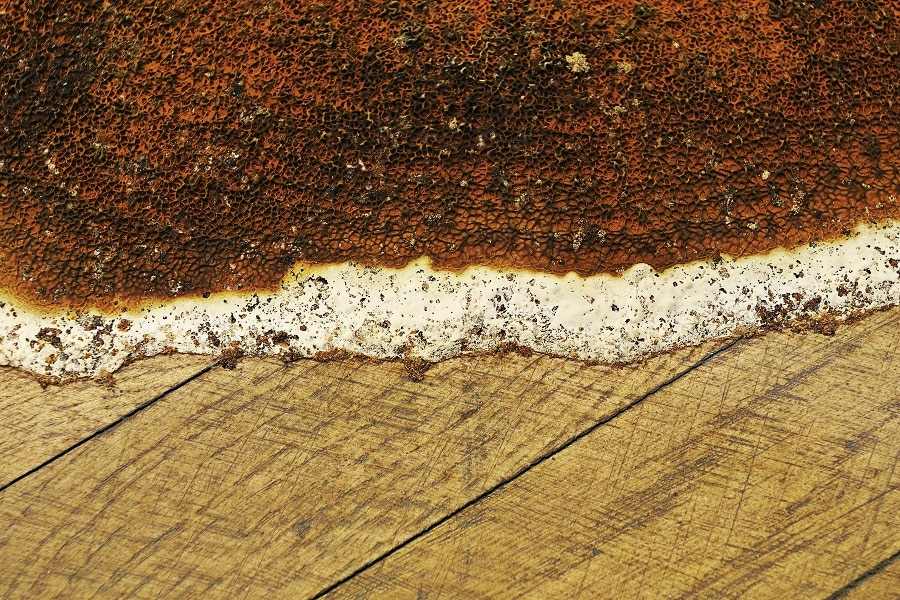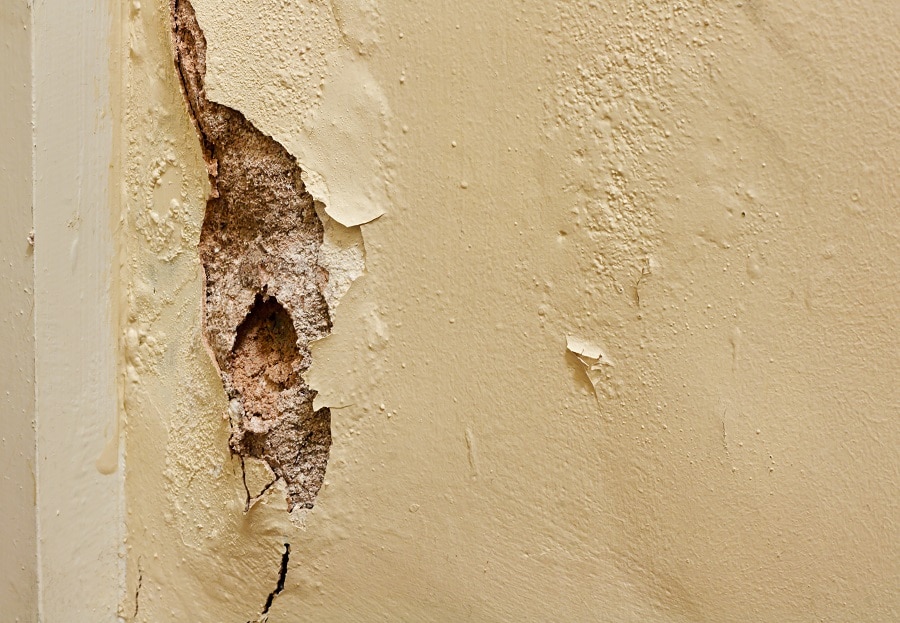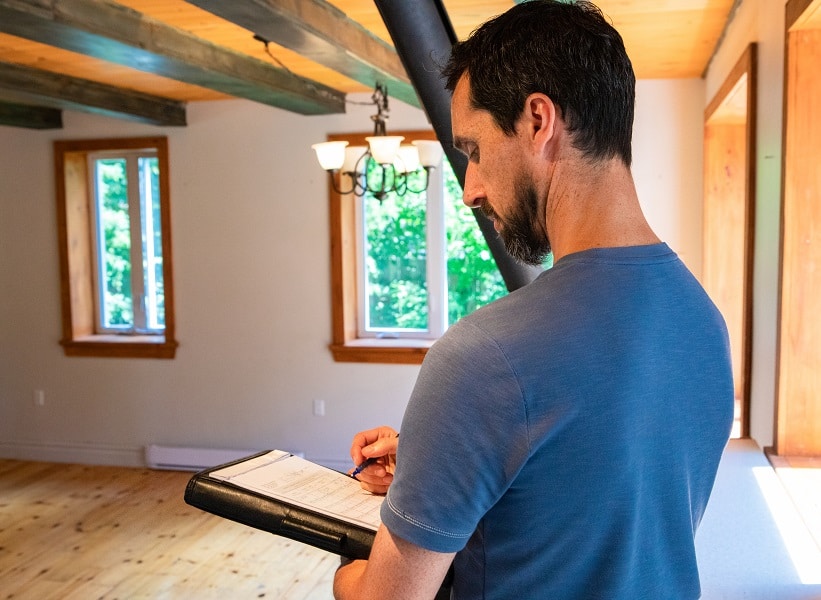What is dry rot?
Dry rot is a general term for Wood-decay fungus. The wood is broken down by fungi, as the Mycelium decomposes the wood, resulting in fine dust particles that are made of sawdust and wood chips, forming colonized areas that are referred to as fungal blooms. Dry rot is caused by fungal spores which require a suitable place to land and start their colonies before spreading through the underlying wood. A lot of these spores are present in soil and old wood already infected by dry rot.
This ensures that even treated wood will be re-infected with dry rot if it is wet enough (i.e., below 15 percent relative humidity). Dry rot attacks the structural parts of a property such as floor joists and rafters undetected, unlike wet rot which can only attack damp timber. It sometimes happens where you’re not looking. This could be found behind the plaster, beneath your floorboards, or even in your loft. This is why it’s essential to know the signs and symptoms of dry rot and to get it treated quickly.
Our Guarantee
- upto 30 year guarantee
- customer focused team
- 20 years combined experience
- portfolio of satified customers
- attention to detail
- Construction line accreditation
- public liability insurance
- CHAS accreditation
What is the difference between dry rot and wet rot?
Dry rot and wet rot are two different kinds of fungus that can destroy wood if left untreated. The biggest difference between dry rot and wet rot is the moisture that wet rod needs in order to spread. Another significant difference to be aware of is that wet rot can spread across larger areas faster. That’s right because timber based products never come into contact with mycelium – the fungus that causes Dry Rot to form. Dry rot fungus can be “silent”, but it is very active and spreads incredibly quickly once it has taken hold in a property. The consequences of wet rot fungus are not that serious, the decay is confined to areas where the timber becomes and remains wet.
Call Our Sussex Damp Experts team now for quote, consultation and advice:
Call on 01273 257 765.
What are the causes of dry rot?
A number of fungi cause dry rot. The most commonly found in the Hailsham is Serpula Lacrymans. If it is not managed on time, it will grow and spread throughout your home causing structural damage. This would damage the integrity of your structural wood, and thus the structural integrity of your whole residence. Dry rot attacks when you have an unhealthy amount of moisture in your timber. The fungus will use the moisture and nutrients to grow and reproduce. The expression “dry rot” is used to contrast between “wet wood” and “dry wood rot.”
Wet timber fodder on a dry rot. These hyphae need only 20% moisture to survive, while fungal spores need more than 30% moisture to generate hyphae after this. This hyphae can develop into a fungal body known as mycelium, which can disperse and find more wood in brick and stone. The fungi will remove hemicellulose, cellulose, and H2O, leaving behind a weak structure of the original wood. You will need a specialist survey to distinguish whether your decaying timber is being caused by dry rot or by a different fungus. This is really important since the cure for these damages can differ based on the actual cause.

The dangers of dry rot in Hailsham
Dry Rot Effect on your Property
Dry rot spreads so fast it can possibly cause you to lose your house integrity. As Dry Rot breaks down your properties structural timber, it will eventually cause it to crumble. In serious circumstances, it can cause various parts of your house to fall apart. Dry rot causes the wood to become brittle and fall apart when it gets wet, but can only travel across brick or stone. This is why regular checks are important.
Dry Rot is one of the most destructive and dangerous pests found in homes, which requires urgent treatment. When you know a dry rot problem is imminent, call in the experts at Dry Rot Experts and Rescue. If you think you may have a damp problem use our home survey form on our website.
Dry Rot Effect on Your personal health
It’s not the disease that causes dry rot that is dangerous. Regrettably, if dry rot does occur, the structural damage may be extensive to your health. This is extremely unhealthy for the infants, elderly people and those with respiratory problems like asthma.
What are the Warning Signs of Dry Rot?
If you discover dry rot early on, you’ll be able to save yourself time and money. If you see some of the signs and symptoms listed below, a complete examination is recommended.
-
The beginning of the dry rot cycle
Fungi spores may travel through air via wind in order to infect a new host. The insect cuts small holes into the wood and eats the sap that comes out. When they feed on it, they will then germinate and create hyphae, if the timber is giving them enough nutrients to do so. As these hyphae expand and eat, they may enter a spider web-like array called mycelium. Mycelium can be light grey to pure white. This mycelium can also reach into your properties bricks, mortar and wood to try and reach more of your timber.
-
Your timber is damaged.
You are likely to start noticing rot issues if your timber begins to dry out. This may at times make your wood fall. You will probably note the dry rot blacken the color of your wood. Cuboidal cracking can be caused by dry rot. Cuboidal cracking occurs when the wood breaks into cubes that are about 50 mm in width. Sometimes, this damaged wood may also have hyphae, white fungal growth. Hyphae are spider-like fungal growth, they look like cobwebs and are a common symptom of dry rot.
-
Your timber will smell.
If you detect a distinct dour, you should have your timber checked for dry rot. This can occur even if you can’t see a dry rot outbreak. Despite the odor, dry rot may not yet begun to grow.
-
Your timber will have fungus bodies on it.
Dry rot is the most noticeable kind of wood rot and one of the final stages of fungal attack. Mushroom-like fruiting bodies can start attaching themselves to your timber. If it becomes dry, dry rot can no longer feed on the wood so it will pop out spores instead.
-
Your timber will have spore dust.
Spores of the dry rot fungus don’t just occur in woods already affected by dry rot. It is a sign of dry rot when splotches of corroded dust embedded dry rot spores. Fertile bodies supply this spore dust in the final cycle of dry rot.
Dry Rot Treatment in Hailsham

A dry rot attack would not happen until the moisture level is over 20 percent. The first safeguard to remove the presence of fungi is the monitoring of your living room or property’s moisture levels. Then the moisture levels will be under your control. Consult a professional for a proper treatment of your dry rot.
Sussex Damp Experts will help remove ant timber removal and other remedial works. Any affected timber should be handled by a professional. Similarly, a professional damp proofing expert will know the exact treatment required. Timber treatment can be into the timber, or on the surface of the timer. Options for preventive treatment are many. These chemicals require specific concentrations and can have unpleasant side effects if inhaled or injected accidentally.
Boron rods can also be inserted into your timber by an expert. Boron is a radioactive compound, which is why our damp proofing experts all wear the protective clothing. Our damp proofing team will find and fix your leaks and resolve any dry rot damage. Dry rots can be a severe issue and need to be treated right away. In order to protect a wooden structure, it’s critical to treat dry rot immediately. We will provide a damp proofing solution that is right for your needs. Please don’t waste time. Call today 01273 257 765, for a free survey, and effective treatment of dry rot.
How can you prevent dry rot damage in Hailsham?
The first treatment phase is the removal of dry rot. A dry rot infestation will occur in any wooden areas of the house that traps ample water and is subject to moisture/moisture ingress. Practices that prevent them from forming: Confirm that your house doesn’t have any leaks. Facilitate sufficient ventilation.
Well, ventilate and enclose the attic. Properly freshen crawlspaces. To minimize ground moisture, seal basement and crawlspace floors Check all wall and roof flashing to ensure water is being directed properly. Keep drains and downspouts clear. Check for plumbing/heating leaks if using a “wet” system. Because of the moist conditions required for dry rot fungus to feed and germinates, the best way to reduce the risk of dry rot is to minimize moisture levels. For example, plugging the leak will help avoid dry redness by providing a pipe that leaks.
Speak to a Dry Rot specialist in Hailsham
We are equipped to deal with any damp proofing or dry rot problems affecting your property or home. We will provide a free written estimate prior to beginning any work so that you know exactly what to expect. Over the years, with their damp concerns, we have helped thousands of Hailsham homeowners, and we will support you too. Contact us on 01273 257 765 for a free quote and survey. An expert will be able to assess your dry rot problem. We are not tied to any special interest groups or companies, and can therefore give you advice on the treatments that will be best for you.

We have a complete list of expert surveyors who carry out all types of surveys and assessments, from pre-purchase surveys to full structural repairs. Dry rot by its nature gets worse over time, if you think you have a problem, it is important to contact us right away. Sussex Damp Experts will be able to help you no matter what the nature of your damp issue is, email or call us on 01273 257 765
FAQ
Should dry rot be restored or replaced?
A certain level of dry rot can be repaired, but whether the damaged areas provide the house with structural stability, such as beams and joints, or even flooring, it is not recommended. Replace the wood in such a situation instead of repairing it. Whether you restore or rebuild the wood, it is better if you avoided the conditions that caused the rot to flourish in the first place or risked it coming back. Your roof leaks, broken gutters, or downspouts, plumbing leaks or insufficient ventilation should be inspected when considering a roof moisture accumulation You may consult a specialist to find and repair the problem.
Will you be able to treat my Dry Rot problem effectively?
With our expertly trained surveyors and specialists, a dry rot problem can be treated, rectified, and your timber can be protected for the future.
How do I discover how far Dry Rot has spread?
If you have traced the dry rot fungus quickly or not, a professional will identify the source of the problem. They will be able to trace the fungus in the different masonry and plaster from which it has spread.
How much can dry rot widen?
Dry rot spores can spread in anyplace with the right environmental settings. The reason is that they are carried in the atmosphere. If your timber has a moisture content of around 20%, and if it is in the open air, these conditions are attractive to dry rot fungus. This suggests that fungus groups can disperse to multiple materials. If dry rot is spreading across masonry and plaster, and if it reaches more timber to feed off where the timber is moist. It can widen further. Dry rot fungus needs five things to survive: the right temperature, drive rot spores, moisture, oxygen, and the food source. In any home in Brighton most of this is present.
Will dry rot stretch?
What should I do to control dry rot?
First identify the reason for your timber moist before solving it. A different treatment shall be given if the reason for your timber moisture is outside.
What are the effects of living dry rot unchecked?
Dry rot is the most insidious form of moisture that can infest property and cause permanent damage to the building if left untreated. Sometimes, once the harm is already done due to the places in which the problem is likely to be the presence of dry rot does not come to light.
Is dry rot stringent?
Dry rot can be particularly common in wooden properties, so it is essential that early signs of dry rot are identified before the damage becomes too severe.
How am I meant to know if I have dry rot?
A timber survey will assess how your timber is affected by being exposed to moisture. Later on, fruiting bodies and mycelium will be noticeable in the drive rot life-cycle.
Where can dry rot grow?
Dry rot attacks and rots timber that’s been in contact with water for a long period of time. Although it can often be mistaken for other problems in its early stages, it is important to seek advice. In every structure, both old and new, dry rot can grow. The reason being that it is caused by moisture and wetness that happen anyplace. Dry rot can be caused by leaks or weather, meaning the type of property does not affect it.




